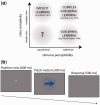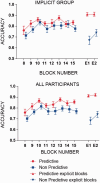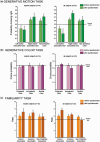Unconscious associative learning with conscious cues
- PMID: 30397511
- PMCID: PMC6210405
- DOI: 10.1093/nc/niw016
Unconscious associative learning with conscious cues
Abstract
Despite extensive research, the very existence of unconscious learning in humans remains much debated. Skepticism arises chiefly from the difficulty in assessing the level of awareness of the complex associations learned in classical implicit learning paradigms. Here, we show that simple associations between colors and motion directions can be learned unconsciously. In each trial, participants had to report the motion direction of a patch of colored dots but unbeknownst to the participants, two out of the three possible colors were always associated with a given direction/response, while one was uninformative. We confirm the lack of awareness by using several tasks, fulfilling the most stringent criteria. In addition, we show the crucial role of trial-by-trial feedback, and that both the stimulus-response (motor) and stimulus-stimulus (perceptual) associations were learned. In conclusion, we demonstrate that simple associations between supraliminal stimulus features can be learned unconsciously, providing a novel framework to study unconscious learning.
Keywords: Unconscious learning; consciousness; implicit learning; motion discrimination; reinforcement learning.
Figures






References
-
- Atas A, Faivre N, Timmermans B. et al. Nonconscious learning from crowded sequences. Psychol Sci 2014;25:113–9. doi:10.1177/0956797613499591 - PubMed
-
- Bahrami B, Carmel D, Walsh V. et al. Unconscious orientation processing depends on perceptual load. J Vis 2008;8:12.1–0. doi:10.1167/8.3.12 - PubMed
-
- Berry DC, Broadbent DE. On the relationship between task performance and associated verbalizable knowledge. Quart J Exp Psychol Section A 1984;36:37–41. doi:10.1080/14640748408402156
-
- Brainard DH. The psychophysics toolbox. Spat Vis 1997;10:433–6. Retrieved from http://www.ncbi.nlm.nih.gov/pubmed/9176952. Last access 2016, August 17. - PubMed
-
- Carmel D, Saker P, Rees G. et al. Perceptual load modulates conscious flicker perception. J Vis 2007;7:1–13. doi:10.1167/7.14.14 - PubMed
LinkOut - more resources
Full Text Sources
